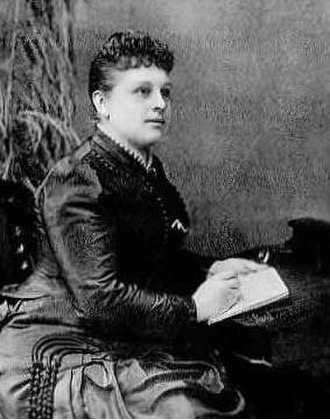by Barbara D. Ferguson

Julia Ames, c.1880, photographer unknown. Image Courtesy Wikimedia Commons
By the time my article about W.T. Stead’s often-overlooked spiritualist periodical Borderland found a home at the Victorian Review, it had already been a graduate seminar presentation, a semester-end essay, a VSAWC conference paper, and a guest lecture. Navigating its research rabbit holes and shifting formats, I sometimes wished I too had a collaborator, as Stead had had Miss X (Ada Goodrich Freer) and Julia for Borderland. Stead openly acknowledged his collaborators in the pages of the work, recognizing Miss X as a prolific spiritualist writer and co-editor, and Julia as the spirit of American journalist Julia Ames, dead more than a year when the periodical launched.
Of course, if I had found even one such collaborator – allowing us to eschew both Zoom and email in favour of telepathy or automatic writing – our results would have raised the same issues Stead’s did more than a century ago: as amanuensis, how would I be able to mediate between my collaborator’s thoughts and my own, or indeed discern one from the other? How would we signal on the page who had written what? And, inevitably, would anyone even take me seriously if I co-authored with a spirit, or would my friends and colleagues tell me I had taken a career-ending misstep onto the fringes of acceptable behaviour?
Stead contended with all these concerns as he and Freer launched Borderland in 1893. He had already established himself as a cultural figure, an author/editor with connections and media clout to be reckoned with, albeit also one with a reputation and a prison record from his years of investigative work. Using multiple pages of the first few editions of Borderland to reprint letters of support and criticism, where activist Josephine Butler, biologist Alfred Russel Wallace, and newspaper editor T.P. O’Connor appear alongside Members of Parliament, regional clerics, and obscure academics is typical of Stead’s social reach and willingness to court public comment (“The Response to the Appeal” pp.10-23; “Some More Opinions on the Study of Borderland” pp.103-113, etc.). Stead’s version of the New Journalism was, by his own publicized assertions, one which strove to influence audiences into action more effectively than any other communication platform. For Stead, the journalistic author was an embodied force on and off the page, present abstractly in their printed byline and voice, and more materially in their public self as a gatherer of information, “at once the eye and the ear and the tongue of the people,” and the means by which those people were represented in print (“Government by Journalism” par.7).
Given his imagining of the journalist’s role as an informational relay – a body simultaneously present and absent in the process of textual transmission – it seems to me hardly surprising that Stead accepted the role as Julia’s amanuensis with little qualm (“My Experience” pp.41-4). Wielding his familiar tools from the New Journalism, he expanded his readership into the spiritualist community by foregrounding Borderland’s collaborative ethos, printing rather thrilling tales of first-person accounts of the uncanny, and recurrently featuring a female voice as an authoritative speaker on the afterlife. On those levels, the project seems entirely in keeping with the savvy journalist Stead had long been. But resolving just how to present these dual-authored messages on the page, and how to attribute the words of each speaker when both he and she were, by his own account, writing as a single being with two consciousnesses… that proved more difficult, and indeed challenged the very tenets of the New Journalism Stead had so long championed.
For more about Stead’s reconfiguration of voice and the new journalism for spiritualist audiences, see Barbara D. Ferguson’s “‘My Spook Speaks Steadease:’ Voice, Mediation, and the New Journalism in W.T. Stead’s Borderland.” Victorian Review, issue 47, Spring 2021, pp. 135-52.
Works Cited
Stead, W.T. “Government by Journalism.” Contemporary Review, vol. 49, May 1886, pp. 653–74.
—. “Some More Opinions on the Study of Borderland.” [Various authors] Borderland, vol. 1, no. 2, October 1893, pp. 103-113.
“ This entry was posted in Blog and tagged Spiritualism on .
